GMC ACADIA 2012 Owner's Manual
Manufacturer: GMC, Model Year: 2012, Model line: ACADIA, Model: GMC ACADIA 2012Pages: 468, PDF Size: 5.57 MB
Page 101 of 468
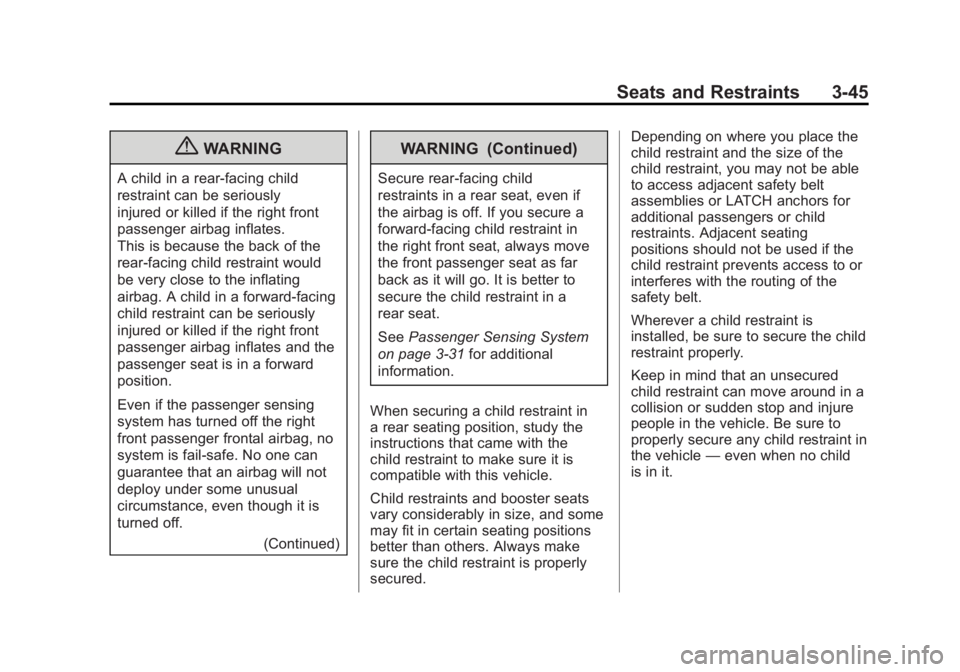
Black plate (45,1)GMC Acadia/Acadia Denali Owner Manual - 2012
Seats and Restraints 3-45
{WARNING
A child in a rear-facing child
restraint can be seriously
injured or killed if the right front
passenger airbag inflates.
This is because the back of the
rear-facing child restraint would
be very close to the inflating
airbag. A child in a forward-facing
child restraint can be seriously
injured or killed if the right front
passenger airbag inflates and the
passenger seat is in a forward
position.
Even if the passenger sensing
system has turned off the right
front passenger frontal airbag, no
system is fail-safe. No one can
guarantee that an airbag will not
deploy under some unusual
circumstance, even though it is
turned off.(Continued)
WARNING (Continued)
Secure rear-facing child
restraints in a rear seat, even if
the airbag is off. If you secure a
forward-facing child restraint in
the right front seat, always move
the front passenger seat as far
back as it will go. It is better to
secure the child restraint in a
rear seat.
SeePassenger Sensing System
on page 3‑31 for additional
information.
When securing a child restraint in
a rear seating position, study the
instructions that came with the
child restraint to make sure it is
compatible with this vehicle.
Child restraints and booster seats
vary considerably in size, and some
may fit in certain seating positions
better than others. Always make
sure the child restraint is properly
secured. Depending on where you place the
child restraint and the size of the
child restraint, you may not be able
to access adjacent safety belt
assemblies or LATCH anchors for
additional passengers or child
restraints. Adjacent seating
positions should not be used if the
child restraint prevents access to or
interferes with the routing of the
safety belt.
Wherever a child restraint is
installed, be sure to secure the child
restraint properly.
Keep in mind that an unsecured
child restraint can move around in a
collision or sudden stop and injure
people in the vehicle. Be sure to
properly secure any child restraint in
the vehicle
—even when no child
is in it.
Page 102 of 468
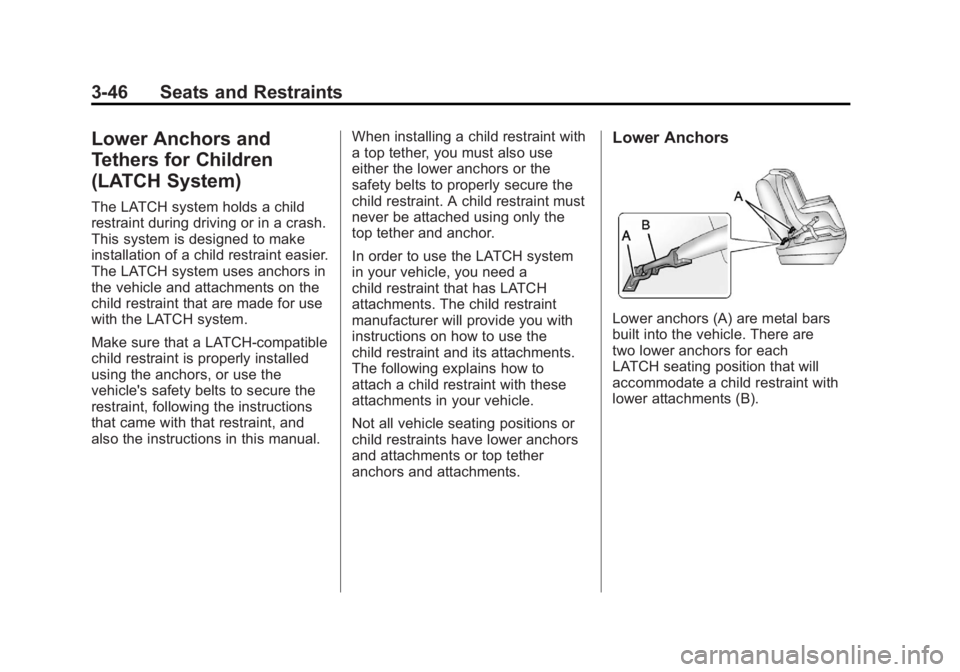
Black plate (46,1)GMC Acadia/Acadia Denali Owner Manual - 2012
3-46 Seats and Restraints
Lower Anchors and
Tethers for Children
(LATCH System)
The LATCH system holds a child
restraint during driving or in a crash.
This system is designed to make
installation of a child restraint easier.
The LATCH system uses anchors in
the vehicle and attachments on the
child restraint that are made for use
with the LATCH system.
Make sure that a LATCH-compatible
child restraint is properly installed
using the anchors, or use the
vehicle's safety belts to secure the
restraint, following the instructions
that came with that restraint, and
also the instructions in this manual.When installing a child restraint with
a top tether, you must also use
either the lower anchors or the
safety belts to properly secure the
child restraint. A child restraint must
never be attached using only the
top tether and anchor.
In order to use the LATCH system
in your vehicle, you need a
child restraint that has LATCH
attachments. The child restraint
manufacturer will provide you with
instructions on how to use the
child restraint and its attachments.
The following explains how to
attach a child restraint with these
attachments in your vehicle.
Not all vehicle seating positions or
child restraints have lower anchors
and attachments or top tether
anchors and attachments.
Lower Anchors
Lower anchors (A) are metal bars
built into the vehicle. There are
two lower anchors for each
LATCH seating position that will
accommodate a child restraint with
lower attachments (B).
Page 103 of 468
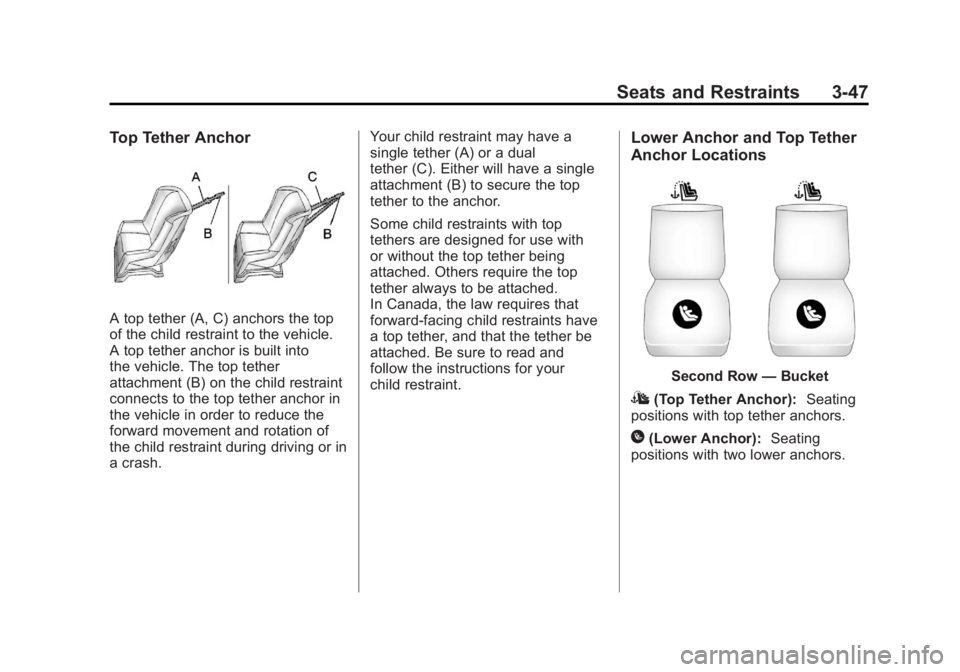
Black plate (47,1)GMC Acadia/Acadia Denali Owner Manual - 2012
Seats and Restraints 3-47
Top Tether Anchor
A top tether (A, C) anchors the top
of the child restraint to the vehicle.
A top tether anchor is built into
the vehicle. The top tether
attachment (B) on the child restraint
connects to the top tether anchor in
the vehicle in order to reduce the
forward movement and rotation of
the child restraint during driving or in
a crash.Your child restraint may have a
single tether (A) or a dual
tether (C). Either will have a single
attachment (B) to secure the top
tether to the anchor.
Some child restraints with top
tethers are designed for use with
or without the top tether being
attached. Others require the top
tether always to be attached.
In Canada, the law requires that
forward-facing child restraints have
a top tether, and that the tether be
attached. Be sure to read and
follow the instructions for your
child restraint.
Lower Anchor and Top Tether
Anchor Locations
Second Row
—Bucket
I(Top Tether Anchor): Seating
positions with top tether anchors.
H(Lower Anchor): Seating
positions with two lower anchors.
Page 104 of 468
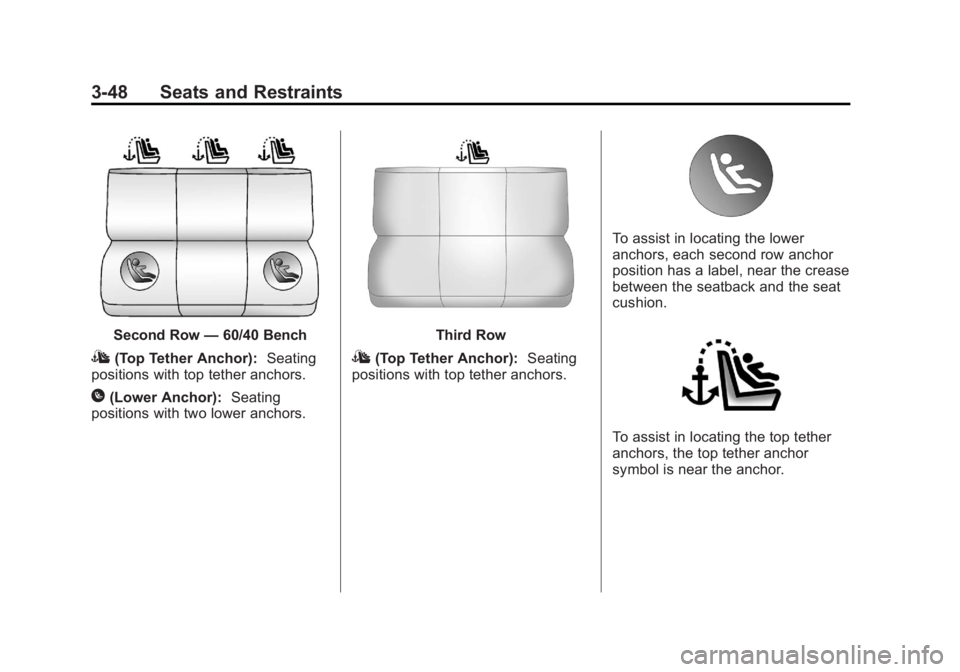
Black plate (48,1)GMC Acadia/Acadia Denali Owner Manual - 2012
3-48 Seats and Restraints
Second Row—60/40 Bench
I(Top Tether Anchor): Seating
positions with top tether anchors.
H(Lower Anchor): Seating
positions with two lower anchors.
Third Row
I(Top Tether Anchor): Seating
positions with top tether anchors.
To assist in locating the lower
anchors, each second row anchor
position has a label, near the crease
between the seatback and the seat
cushion.
To assist in locating the top tether
anchors, the top tether anchor
symbol is near the anchor.
Page 105 of 468
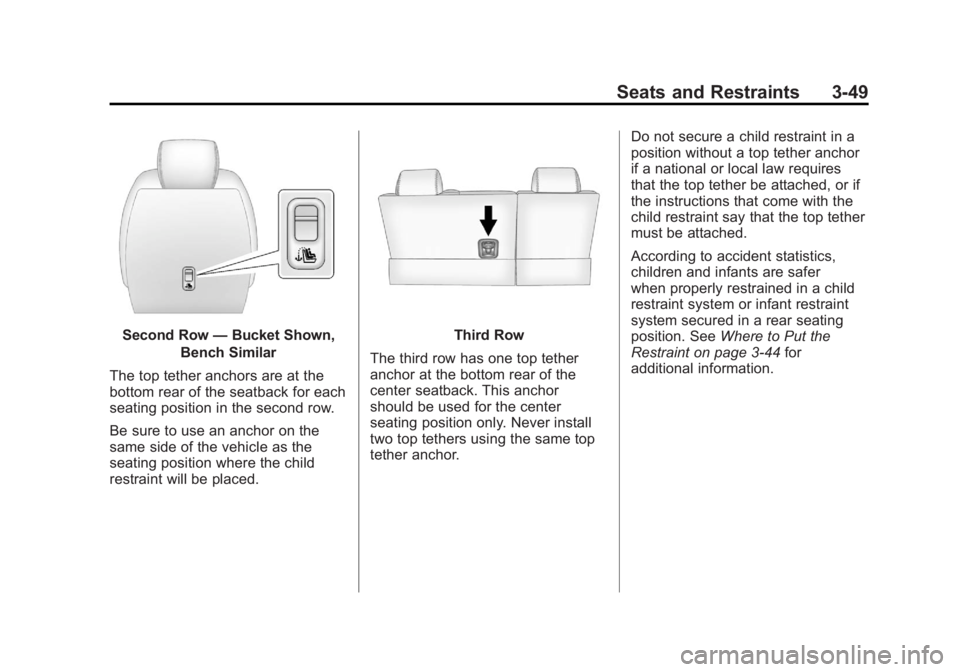
Black plate (49,1)GMC Acadia/Acadia Denali Owner Manual - 2012
Seats and Restraints 3-49
Second Row—Bucket Shown,
Bench Similar
The top tether anchors are at the
bottom rear of the seatback for each
seating position in the second row.
Be sure to use an anchor on the
same side of the vehicle as the
seating position where the child
restraint will be placed.Third Row
The third row has one top tether
anchor at the bottom rear of the
center seatback. This anchor
should be used for the center
seating position only. Never install
two top tethers using the same top
tether anchor. Do not secure a child restraint in a
position without a top tether anchor
if a national or local law requires
that the top tether be attached, or if
the instructions that come with the
child restraint say that the top tether
must be attached.
According to accident statistics,
children and infants are safer
when properly restrained in a child
restraint system or infant restraint
system secured in a rear seating
position. See
Where to Put the
Restraint on page 3‑44 for
additional information.
Page 106 of 468
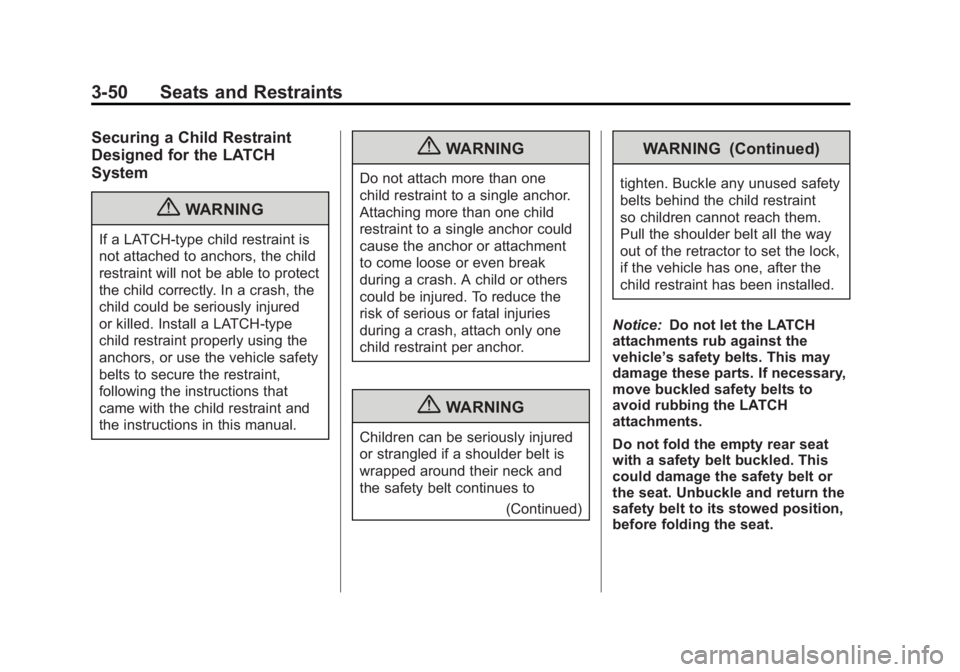
Black plate (50,1)GMC Acadia/Acadia Denali Owner Manual - 2012
3-50 Seats and Restraints
Securing a Child Restraint
Designed for the LATCH
System
{WARNING
If a LATCH-type child restraint is
not attached to anchors, the child
restraint will not be able to protect
the child correctly. In a crash, the
child could be seriously injured
or killed. Install a LATCH-type
child restraint properly using the
anchors, or use the vehicle safety
belts to secure the restraint,
following the instructions that
came with the child restraint and
the instructions in this manual.
{WARNING
Do not attach more than one
child restraint to a single anchor.
Attaching more than one child
restraint to a single anchor could
cause the anchor or attachment
to come loose or even break
during a crash. A child or others
could be injured. To reduce the
risk of serious or fatal injuries
during a crash, attach only one
child restraint per anchor.
{WARNING
Children can be seriously injured
or strangled if a shoulder belt is
wrapped around their neck and
the safety belt continues to(Continued)
WARNING (Continued)
tighten. Buckle any unused safety
belts behind the child restraint
so children cannot reach them.
Pull the shoulder belt all the way
out of the retractor to set the lock,
if the vehicle has one, after the
child restraint has been installed.
Notice: Do not let the LATCH
attachments rub against the
vehicle’ s safety belts. This may
damage these parts. If necessary,
move buckled safety belts to
avoid rubbing the LATCH
attachments.
Do not fold the empty rear seat
with a safety belt buckled. This
could damage the safety belt or
the seat. Unbuckle and return the
safety belt to its stowed position,
before folding the seat.
Page 107 of 468
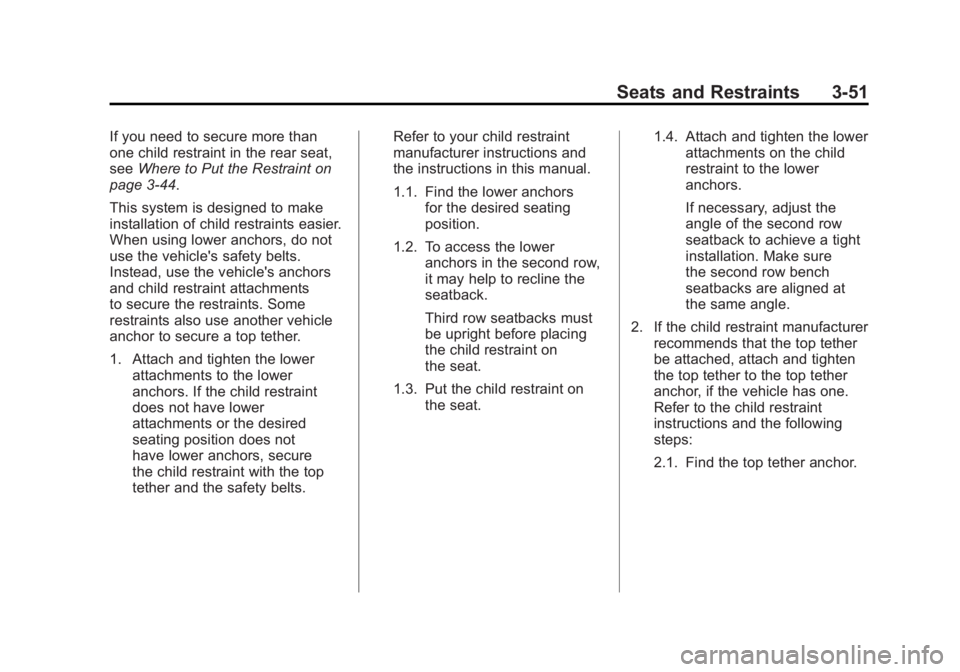
Black plate (51,1)GMC Acadia/Acadia Denali Owner Manual - 2012
Seats and Restraints 3-51
If you need to secure more than
one child restraint in the rear seat,
seeWhere to Put the Restraint on
page 3‑44.
This system is designed to make
installation of child restraints easier.
When using lower anchors, do not
use the vehicle's safety belts.
Instead, use the vehicle's anchors
and child restraint attachments
to secure the restraints. Some
restraints also use another vehicle
anchor to secure a top tether.
1. Attach and tighten the lower attachments to the lower
anchors. If the child restraint
does not have lower
attachments or the desired
seating position does not
have lower anchors, secure
the child restraint with the top
tether and the safety belts. Refer to your child restraint
manufacturer instructions and
the instructions in this manual.
1.1. Find the lower anchors
for the desired seating
position.
1.2. To access the lower anchors in the second row,
it may help to recline the
seatback.
Third row seatbacks must
be upright before placing
the child restraint on
the seat.
1.3. Put the child restraint on the seat. 1.4. Attach and tighten the lower
attachments on the child
restraint to the lower
anchors.
If necessary, adjust the
angle of the second row
seatback to achieve a tight
installation. Make sure
the second row bench
seatbacks are aligned at
the same angle.
2. If the child restraint manufacturer recommends that the top tether
be attached, attach and tighten
the top tether to the top tether
anchor, if the vehicle has one.
Refer to the child restraint
instructions and the following
steps:
2.1. Find the top tether anchor.
Page 108 of 468
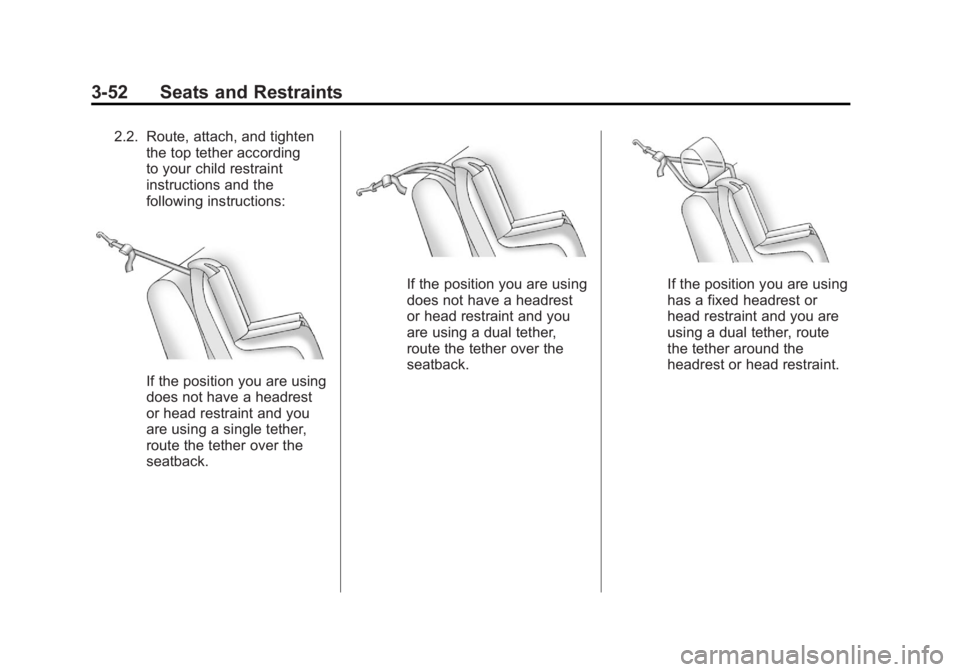
Black plate (52,1)GMC Acadia/Acadia Denali Owner Manual - 2012
3-52 Seats and Restraints
2.2. Route, attach, and tightenthe top tether according
to your child restraint
instructions and the
following instructions:
If the position you are using
does not have a headrest
or head restraint and you
are using a single tether,
route the tether over the
seatback.
If the position you are using
does not have a headrest
or head restraint and you
are using a dual tether,
route the tether over the
seatback.If the position you are using
has a fixed headrest or
head restraint and you are
using a dual tether, route
the tether around the
headrest or head restraint.
Page 109 of 468
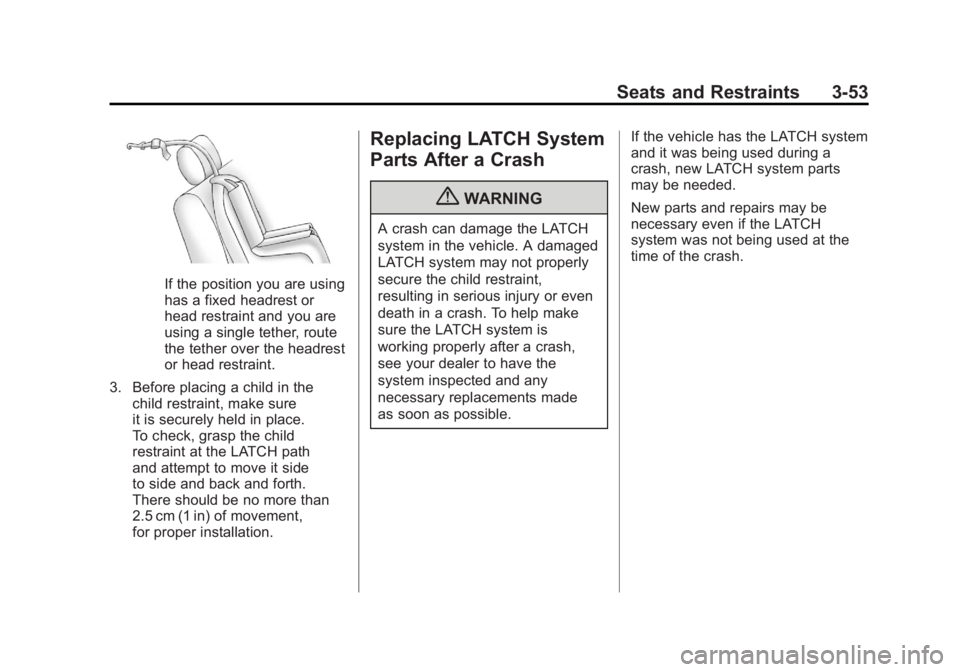
Black plate (53,1)GMC Acadia/Acadia Denali Owner Manual - 2012
Seats and Restraints 3-53
If the position you are using
has a fixed headrest or
head restraint and you are
using a single tether, route
the tether over the headrest
or head restraint.
3. Before placing a child in the child restraint, make sure
it is securely held in place.
To check, grasp the child
restraint at the LATCH path
and attempt to move it side
to side and back and forth.
There should be no more than
2.5 cm (1 in) of movement,
for proper installation.
Replacing LATCH System
Parts After a Crash
{WARNING
A crash can damage the LATCH
system in the vehicle. A damaged
LATCH system may not properly
secure the child restraint,
resulting in serious injury or even
death in a crash. To help make
sure the LATCH system is
working properly after a crash,
see your dealer to have the
system inspected and any
necessary replacements made
as soon as possible. If the vehicle has the LATCH system
and it was being used during a
crash, new LATCH system parts
may be needed.
New parts and repairs may be
necessary even if the LATCH
system was not being used at the
time of the crash.
Page 110 of 468
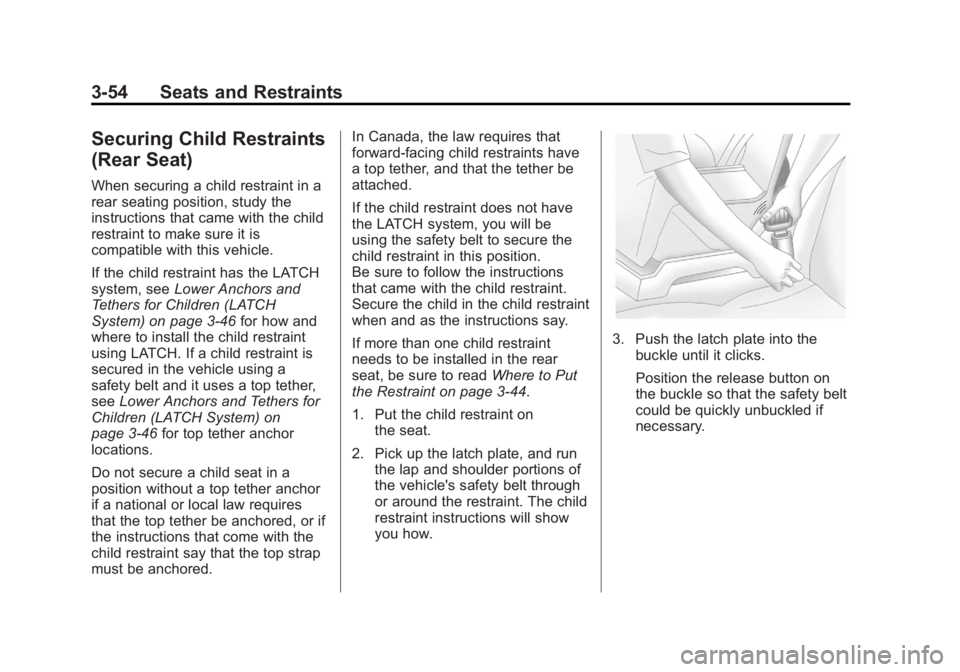
Black plate (54,1)GMC Acadia/Acadia Denali Owner Manual - 2012
3-54 Seats and Restraints
Securing Child Restraints
(Rear Seat)
When securing a child restraint in a
rear seating position, study the
instructions that came with the child
restraint to make sure it is
compatible with this vehicle.
If the child restraint has the LATCH
system, seeLower Anchors and
Tethers for Children (LATCH
System) on page 3‑46 for how and
where to install the child restraint
using LATCH. If a child restraint is
secured in the vehicle using a
safety belt and it uses a top tether,
see Lower Anchors and Tethers for
Children (LATCH System) on
page 3‑46 for top tether anchor
locations.
Do not secure a child seat in a
position without a top tether anchor
if a national or local law requires
that the top tether be anchored, or if
the instructions that come with the
child restraint say that the top strap
must be anchored. In Canada, the law requires that
forward-facing child restraints have
a top tether, and that the tether be
attached.
If the child restraint does not have
the LATCH system, you will be
using the safety belt to secure the
child restraint in this position.
Be sure to follow the instructions
that came with the child restraint.
Secure the child in the child restraint
when and as the instructions say.
If more than one child restraint
needs to be installed in the rear
seat, be sure to read
Where to Put
the Restraint on page 3‑44.
1. Put the child restraint on the seat.
2. Pick up the latch plate, and run the lap and shoulder portions of
the vehicle's safety belt through
or around the restraint. The child
restraint instructions will show
you how.
3. Push the latch plate into the
buckle until it clicks.
Position the release button on
the buckle so that the safety belt
could be quickly unbuckled if
necessary.